February 14, 2025
Air Date: February 14, 2025
FULL SHOW
SEGMENTS
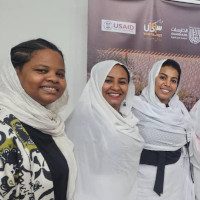
No Help From America
View the page for this story
The Trump administration’s attempt to freeze all foreign assistance and bid to lay off nearly all USAID staffers are bringing disastrous consequences for millions of acutely hungry people, including those in war-torn Sudan. Nisreen Elsaim is a Sudanese climate and environmental activist and joins Host Jenni Doering to describe the desperate situation and send a warning to the US about the perils of isolationism. (12:13)
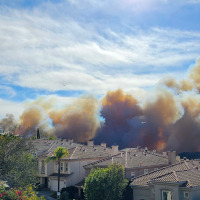
"Climate Whiplash" Between Extreme Wet and Dry
View the page for this story
Global warming is increasing the frequency and severity of “climate whiplash” events, which are rapid transitions between very wet and very dry conditions. One such event set the stage for the devastating L.A. wildfires in January 2025. Dr. Daniel Swain is a climate scientist with the University of California Agriculture and Natural Resources and joins Host Paloma Beltran to explain how climate whiplash works and what societies need to do to prepare. (10:58)
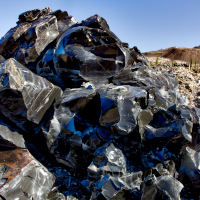
Exploring the Parks: Brand-New Sáttítla Highlands National Monument
View the page for this story
In his last days in office President Biden designated the new Sáttítla Highlands National Monument in northern California. Hosts Paloma Beltran and Jenni Doering discuss the otherworldly volcanic landscape and its importance to local tribes. (07:07)
"The Silence"- Lava Tubes of Iceland
/ Mark Seth LenderView the page for this story
Escaping the noise of the world can be hard these days, but not impossible. Living on Earth’s Explorer in Residence Mark Seth Lender has stumbled upon silent sanctuaries in Iceland and beyond. (04:24)
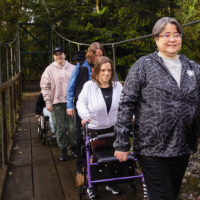
'EXPLORE' Act and Outdoor Accessibility
View the page for this story
A new bipartisan law aims to help people of all abilities explore the outdoors. Syren Nagakyrie founded the nonprofit Disabled Hikers and joins Host Jenni Doering to share insights about the challenges people with disabilities face visiting America’s public lands and how the new law could help. (10:36)
Show Credits and Funders
Show Transcript
HOSTS: Paloma Beltran, Jenni Doering
GUESTS: Nisreen Elsaim, Syren Nagakyrie, Daniel Swain
REPORTERS: Mark Seth Lender
[THEME]
DOERING: I’m Jenni Doering.
BELTRAN: And I’m Paloma Beltran.
Climate whiplash is an emerging hallmark of climate disruption.
SWAIN: Increasing hydroclimate whiplash, even if it hasn’t emerged yet locally, in your backyard, it probably will with continued warming. This really is going to be, in all likelihood, a near-universal experience over global land areas, nearly as much so as the warming temperatures themselves.
DOERING: Also, the new and stunning Sáttítla Highlands National Monument in Northern California.
JOSLIN: In the top of the caldera is a large lake called Medicine Lake, and off in the distance you can see a large obsidian flow that's like black glass that just kind of shimmers in the sun. It's really kind of almost like a Martian landscape in places.
[NEWSBREAK MUSIC: Boards Of Canada “Zoetrope” from “In A Beautiful Place Out In The Country” (Warp Records 2000)]
[THEME]
No Help From America
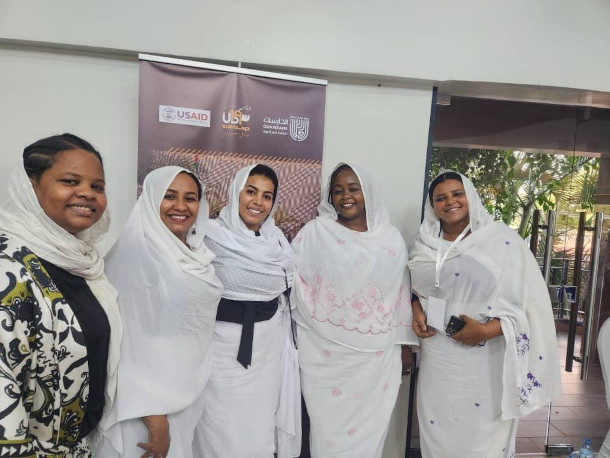
Climate and environmental activist Nisreen Elsaim (far left) volunteers in Doha, Qatar, with the Female Guardians of the Revolution (right), a Sudanese NGO that serves the therapeutic and psychological needs of female refugees. Elsaim is concerned that the Trump administration’s shutdown of USAID could not only have devastating immediate consequences but could scar the fabric of American foreign policy for decades to come. (Photo: Nisreen Elsaim)
BELTRAN: From PRX and the Jennifer and Ted Stanley Studios at the University of Massachusetts, Boston, this is Living on Earth. I’m Paloma Beltran.
DOERING: And I’m Jenni Doering.
In 1961, President John F. Kennedy founded the United States Agency for International Development. USAID was the right hand of American soft power during the height of the Cold War. Agency staff and contractors fanned out throughout the developing world bearing the fruits of America’s bounty, like health care, nutrition, infrastructure and education programs. And for populations ravaged by war and famine, USAID funding and supplies provided an invaluable lifeline.
BELTRAN: But this lifesaving work has been thrown into chaos with the Trump administration orders to freeze all foreign assistance and lay off nearly all USAID staffers. To get a better picture of the impact on one of the most vulnerable populations in the world we reached out to Sudanese climate and environmental activist Nisreen Elsaim. Nisreen fled her home in Khartoum with her infant son following the outbreak of the fighting between two rival military factions in 2023. Climate disruption from extreme droughts to floods has aggravated the humanitarian crisis, and now the UN says nearly 25 million people, or half the Sudanese population, face acute hunger.
DOERING: Nisreen spoke to us from Doha, Qatar where she is a volunteer with Sudanese NGO, Female Guardians of the Revolution, which provides psychological and therapeutic support for women refugees. Please be aware our discussion contains events and conditions you may find distressing, including mention of sexual violence.
Nisreen, welcome back to Living on Earth.
ELSAIM: Thank you very much for having me again, and I really hope that one day you will host me in better news.
DOERING: Me too. Now, NBC and other media outlets are reporting that hundreds of community kitchens across Khartoum, Sudan, are being shuttered because of the USAID shutdown. Can you share some of the stories that you've heard?
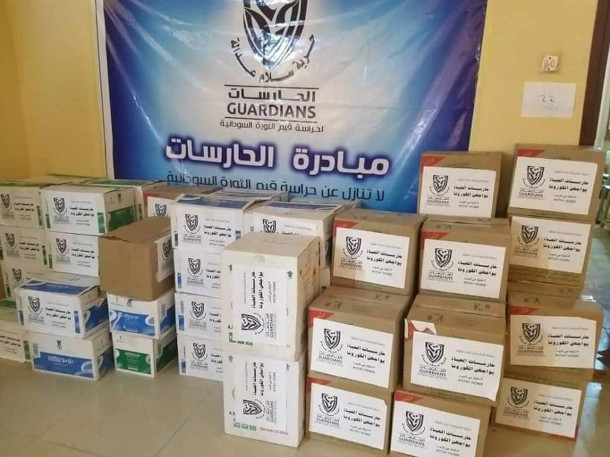
Ramadan, the Islamic holy month of fasting, begins on March 1 in 2025. Female Guardians of the Revolution prepares packages of fruits, nuts, spices and other items for refugees to eat after their daily fast ends. Their staff and volunteers prepare packages in Sudan, Uganda and Egypt. Female Guardians of the Revolution usually receives assistance from the U.S. Agency for International Development in the preparation of Ramadan packages. (Photo: Nisreen Elsaim)
ELSAIM: Yes, so when the siege was built around many, many of the big neighborhoods and cities inside of Sudan and especially in Khartoum, the only way to make food access to people is through the community kitchens. And at the beginning it was purely support from Sudanese diaspora, from people who managed to flee the war but thought of their neighbors, from people who had some savings and could not eat alone. And then it developed into a big initiative, and USAID was one of the biggest supporters to them. And it is very important to highlight that Sudan reached stage five famine more than three times over this two years, which means that the malnutrition situation and access to food is very critical, and food insecurity is the biggest headline of this war right now, unfortunately. And all of this is quite impacted right now by the stop of USAID.
DOERING: What other aid efforts are being disrupted?
ELSAIM: Well, I think health is a huge problem right now in Sudan, because there is no sanitation systems; because of the cholera breakout, the dengue fever breakouts and malaria breakouts. There was a huge aid sector for medicine and hospitals and moving clinics that also stopped. USAID was also one of the biggest supporters for the psychological support that many of the big organizations inside of Sudan, outside of Sudan were giving to the victims of rape, to the victims of the war, people who have traumas from the killing and from the blood and from everything. And I think even if you are hungry one day or two days, then you can eat on the third day. But if you have depression, or if you reach a point where you want to kill yourself after being raped, or if you really need an urgent counseling, all of these activities were very much supported by USAID. I myself, sitting right now in an aid office for an organization. It's a women-led organization, and it's a feminist movement called Harissa, and Harissa is the Arabic name of the Female Guardians of the Revolution, and I can tell you that we worked with almost 10,000 victims right now since the war started, with continuous counseling, and all of these efforts are stopping.
DOERING: Nisreen, it sounds like the people who have been traumatized, especially women who have gone through horrible sexual assaults and need counseling, they will just have to endure going through this alone, more or less with fewer resources and comfort now.
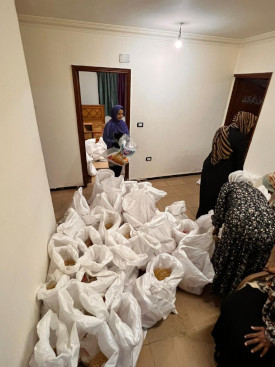
Female Guardians of the Revolution prepare supplies for refugees in their war-torn homeland, Sudan. With the shutdown of USAID operations, millions of refugees are in greater danger of starvation. (Photo: Nisreen Elsaim)
ELSAIM: Yes, and unfortunately, this is something not a lot of organizations work on, because, you know, normally, donors and funders, they have thematic areas that they work on. They have priorities. And I can tell you, not many organizations really have psychological support or mental health in their profile, which leaves a huge gap in this.
DOERING: I understand that USAID has actually provided some support to help during the time of Ramadan, which is coming up. Can you describe what that looked like?
ELSAIM: Yeah, it's normally food. And we used to do what we call Ramadan bag, which is a bag of solids and seeds and oil and some spices and some rice and stuff for people who will be fasting the holy month, and also USAID was a huge supporter for us to do that. And now we keep receiving emails and messages and phone calls asking if we will be able to provide Ramadan bags this year or not, and we are in a continuous search for alternatives. But unfortunately, time is too short. I mean, the decision was so sudden to the point that people now can't find alternatives this quickly, which means that a lot of time-sensitive things like medical support, like Ramadan bags, for example, because it's bounded by Ramadan as a time itself and many other initiatives will have to unfortunately stop this year.
DOERING: Now, given the impact of the climate crisis and the war, how does the interruption of USAID funding and operations further complicate life for the Sudanese people?
ELSAIM: Yes, well, I think the problem is even bigger than USAID, because Trump, if you remember, he pulled out of the Paris Agreement for the second time. And I think especially with climate change, because climate change is not a borders bounded problem. It's not like the war. When you cross the border, then you are in a different country and different reality. Climate change will hit everyone, and you in the U.S. have a very, very recent example of the wildfires that happened in California, and it ate, I'm talking about the fire, but burned and ate one of the most expensive places and houses in the US in general. They didn't say, “Oh, this is celebrities’ houses. I will not touch it. Oh, this is poor people houses. I will just burn it.” It burned everything and everyone. So climate change is not, unfortunately, a problem that is border bounded, and Trump is very much known as a climate denier and it’s not only the USAID, it's not only pulling out of the of the Paris Agreement, but even the White House pages online about climate change is down. If you try to enter any of their pages, it's no longer there. I think re-electing him was a huge setback to the democratic processes of the United States of America as a free country, as a country of opportunity, as a country of law and a country of democracy, I think so.
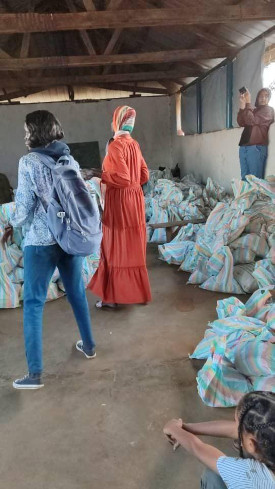
March 1 is the first day of Ramadan 2025. During the holy month, observant Muslims abstain from food and drink from dawn to dusk daily. Female Guardians of the Revolution prepare packages for distribution to refugees in Egypt. (Photo: Nisreen Elsaim)
DOERING: Nisreen, as a humanitarian and an activist, what are your long-term concerns about the impact of the USAID shutdown and these other Trump administration actions?
ELSAIM: I'm really, really worried that institutional changes will happen. I'm really worried that the impact of this four years of Trump ruling the country will not remain in these four years like the previous duration when he was in power, but will leave scars that will stay in the American fabric and the international situation for many years, maybe for decades. I mean, we can only remember what George Bush, the son, did when he entered Iraq. And the Iraq war is still a huge black page in American history, and people are still talking about it, and Iraq still haven't recovered very well. Unfortunately, what a great country like America do does not only impact America, and does not only impact the country, and it does not end by the end of the election period for the candidate, it stays for decades and maybe forever.
DOERING: Now supporters of the Trump administration might argue that other wealthy Arab and European nations should step up and fill the international aid void left by the US government. What's your response to that assertion, and how realistic is it?
ELSAIM: I think it's not about who's going to step up and close which gap, but it was the very good will of the American people and the taxpayers who decided to contribute their money, not only to their own wealth and health and welfare, but also the rest of the world. But if we took one example, for example, the climate change issue, it is an obligation, historical obligation, but also scientific obligation, but the most important ethical and financial obligation to the U.S. because of the history of the emissions since the Industrial Revolution, to really help the developing countries to adapt to climate change and mitigate the emissions of the CO2 but also help other developing countries who have big emissions to shift to green energy. So it's not only a good will, but it's the current economic situation, and the current position of the U.S. in the world was gained by a lot of emissions during the Industrial Revolution, and these emissions are what is causing the climate change that we are all suffering from right now.
DOERING: It sounds like you're saying this isn't just a matter of charity, but of responsibility and duty.
ELSAIM: Definitely.
DOERING: Nisreen, if you could send a message to President Trump and the American people about the importance of USAID to the world, what would you say?
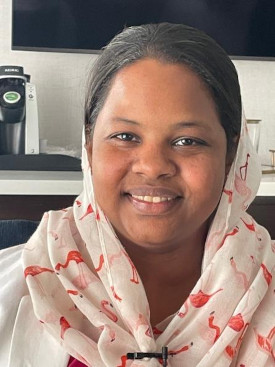
Sudanese Climate and Environmental Activist Nisreen Elsaim during 2024 Climate Week in New York City last fall. Elsaim is concerned that the shutdown of USAID complicates the already dire condition of refugees in her homeland and other troubled areas. (Photo: Nisreen Elsaim)
ELSAIM: I don't think really that I want to send any message to Trump. I don't think it's useful. But what I think it would be really useful to send a message to the Americans, and this message will be definitely what we say about climate change all the time: No one is safe. It's just like the COVID. No one is safe until we are all safe. It goes for everything, like, if you want democracy in your country, then we have to have a democratic world. And this is part of what USAID was doing. If you want a peaceful world, then you have to work for this peace. And this is also what part of what USAID was doing. If you want a healthy planet and healthy people and healthy country, and you don't want other pandemic, like the COVID, then you also need to talk about the health in the whole globe, not only the U.S. And if you remember that some things doesn't really know boundaries, and it will catch you wherever you are. I mean, look how big the distance between China and America, and look how much COVID was impactful, even to the Americans’ life. I mean, it's a very clear example that what happens outside impacts America, and what happens in America impacts the outside.
DOERING: Nisreen Elsaim is a Sudanese environmental and climate activist. Thank you so much, Nisreen.
ELSAIM: Thank you for hosting me again.
Related links:
- Operation Broken Silence | “Chaos Inflicted on USAID Intensifies Famine in Sudan”
- NBC News | “A Lot of People Will Die’: How Trump’s USAID Overhaul Could Lead to Famine in Sudan”
- NPR | “How the Gutting of USAID Is Reverberating Around the World: Worry, Despair, Praise”
- ProPublica | ““People Will Die”: The Trump Administration Said It Lifted Its Ban on Lifesaving Humanitarian Aid. That’s Not True.”
- AP | “Christian Aid Groups Receive Millions in USAID Funds. Now Their Humanitarian Work Is Collapsing.”
[MUSIC: Solafon Rhythm, original percussion piece, Drum Talk TV and YouTube]
BELTRAN: Just ahead, the otherworldly volcanic landscape of the new Sáttítla Highlands National Monument. Keep listening to Living on Earth.
ANNOUNCER: Support for Living on Earth comes from Sailors for the Sea and Oceana. Helping boaters race clean, sail green and protect the seas they love. More information @sailorsforthesea.org.
[CUTAWAY MUSIC: Barbara Higbie, “Land of Gold” on Scenes From Life, by Barbara Higbie, Slowbaby Music]
"Climate Whiplash" Between Extreme Wet and Dry
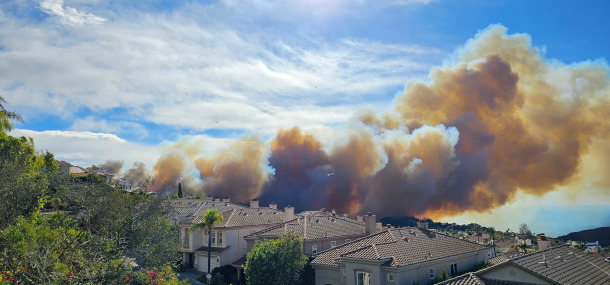
The January 2025 LA wildfires were in part exacerbated by a climate whiplash event, from extreme wet to extreme dry conditions. (Photo: timatymusic, Wikimedia Commons, CC BY 2.0)
DOERING: It’s Living on Earth, I’m Jenni Doering
BELTRAN: And I’m Paloma Beltran.
In the last few years we’ve seen increased rates of catastrophic flooding and droughts. And as we continue to crank up the global thermostat, Earth’s water cycle is changing. In a new paper published in Nature Reviews Earth and Environment, scientists analyzed hundreds of previous studies on how global warming is affecting the water cycle. The authors focused on “hydroclimate volatility,” or climate whiplash, the rapid transition between very wet and very dry conditions, or vice versa. They found that global warming is increasing the frequency and severity of climate whiplash events around the world. And if we pass the threshold of three degrees Centigrade of warming, these events will likely more than double across all kinds of climate zones. Dr. Daniel Swain is a climate scientist with the University of California Agriculture and Natural Resources and lead author on the paper. Welcome to Living on Earth, Daniel!
SWAIN: Thanks for having me.
BELTRAN: So what does climate whiplash look like around the world? You know, give us a sense, please, of how this is playing out in real time?
SWAIN: We've, in this paper, identified a number of globally consequential events that have unfolded just in the past decade, and this isn't even a comprehensive list. One of the more recent ones that actually had occurred immediately before the paper was published, coincidentally, was the much discussed wet to dry whiplash event in Southern California that immediately preceded the catastrophic wildfires in Los Angeles in January of this year. And this wet to dry whiplash event was really important in this context, because the wet part of it allowed a lot of extra growth of grass and brush, which is the main kind of vegetation that was burning in the LA fires, and then the exceptional to record breaking dry period that followed allowed all of that extra biomass to become essentially record dry at the time of year when we get these strong, dry wind storms in the LA area. So that's in some ways the worst possible combination for wildfire in this part of the world. And I think this is a good example of why the whiplash events are in some ways greater than the sum of their parts, in the sense that the fire risk was actually potentially worse in LA this January than it would have been if it had just been dry the whole time. But that particular sequence from wet to dry, with the vegetation growth then desiccation cycle, is what set the stage for the fire disasters to unfold as they did.
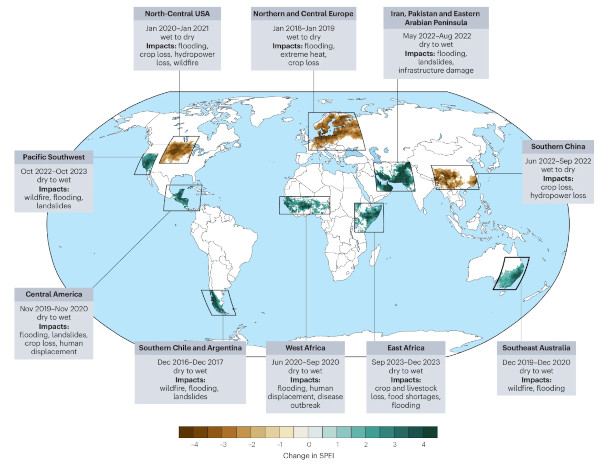
With each degree of warming, the frequency of climate “whiplash” events, or rapid swings between wet and dry conditions, will increase across the globe. (Photo: Swain et al. 2025)
BELTRAN: How exactly are climate change and rising temperatures impacting hydroclimate volatility? You know, what mechanisms are at play here?
SWAIN: Well, most of what's going on actually goes back to the somewhat fundamental thermodynamics of the atmosphere, science that was actually understood beginning in the mid 1800s, so some of our citations in this paper are from the better part of two centuries ago, believe it or not, long before we had climate models. But the basic idea is this: as air temperature rises, the capacity of that air to hold water vapor increases rapidly by about 7% per degree centigrade, or 3 or 4% per degree Fahrenheit of warming. So we essentially encompass all of this in an analogy that we call the expanding atmospheric sponge effect, which is something we coined in this recent paper. You can demonstrate this by taking a small sponge and then a much larger one, and then trying to absorb some water from a container. So the smaller sponge, of course, will absorb a small amount of water. You can wring it out, it yields a certain amount of water. And then the larger sponge, if you put it in a larger container of water, it will absorb more of the water, and then if you wring it out, will yield more water. That's analogous to the increasingly extreme downpours that we see. But it's also the case that that really big sponge still has the capacity to absorb a lot more water, even if there's no water in the container to absorb. And so it retains that thirstiness, that sponginess, if you will, and that is what drives a lot of the effects on the dry side, so worsening droughts and drought related phenomena like wildfires, for example.
BELTRAN: So from what I understand here, hydroclimate volatility doesn't always mean that if I'm in a dry place, it'll get drier, or if I'm in a wet place, it'll get wetter. What framework would you suggest using to make sense of this?
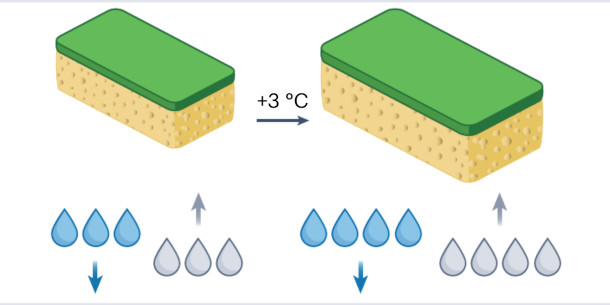
In a warming climate, the atmosphere acts like the larger sponge pictured above. A “thirsty” atmosphere is able to absorb and release more moisture, driving both extreme wet and extreme dry conditions. The authors of the paper call this the “expanding atmospheric sponge effect.” (Photo: Swain et al. 2025)
SWAIN: That's right. You know, what we find is that some places on earth in a warming climate, on average, will get wetter and other places will get drier on average. It really does depend where you are. And you know, in this context, I think it makes sense to think about potentially, that the wet times wherever you are getting wetter and the dry times getting drier. Increasingly, when it does rain, it pours, and when it's very dry, it becomes even drier.
BELTRAN: So how is agriculture going to be impacted by these extreme swings in climate conditions?
SWAIN: Well, you know, agriculture as a largely successful practice for much of modern human civilization, and partly, I think we can credit the success of modern civilization to the success and the advances in agriculture is predicated on a certain level of stability. And where we see periods of instability, whether it's in the climate or the weather or anything else, that tends to be where bad things happen, where people don't have enough to eat, where we see famines occur historically, or food insecurity more commonly today, and what we find is that both kinds of whiplash -- wet to dry and dry to wet -- have both historically been associated with major food security emergencies. Because you can imagine that if you're trying to grow food staple crops, it can be really disruptive to have any kind of sudden change. If you go from wet to dry, your crops may run out of water and bake under the hot sun. But if you go from dry to wet, you might wash your crops away or contaminate the fields potentially. So really, the challenge here is that some of the adverse impacts from these events occur precisely because the transition has been rapid. It's not just that you have a drought, it's not just that you have a flood. In some cases, those might be more manageable on their own, independently, but in other cases, it's the sudden swings, the transition period that just catch people, systems and ecosystems off guard.
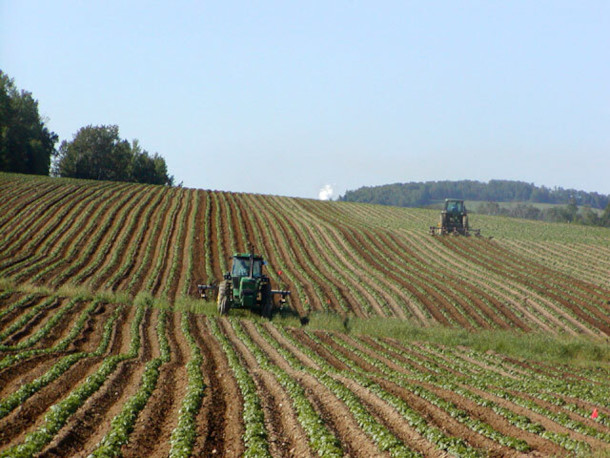
Agriculture, which relies on stability, will be disrupted by increasingly frequent climate whiplash events. (Photo: NightThree, Wikimedia Commons, CC BY 2.0)
BELTRAN: How can government officials and urban planners better prepare for increased instances of climate whiplash? I mean, how do you simultaneously prepare for both extremely wet and extremely dry conditions?
SWAIN: Well, the first step is to acknowledge the reality of increasing projected hydroclimate whiplash in the first place, and to realize that just because your region has recently experienced a lot of drought on the one hand or a lot of flooding on the other does not mean you won't face extremes on the other end of the spectrum. This has been a conversation even in the US and in California, where I work extensively, where there has been a lot of focus on drought and wildfire in recent years, for understandable reasons, but the risk of major flooding does loom large in the background, and I think is a little bit less front of mind. We really need to be thinking about co-managing risks at opposite ends of the hydroclimate spectrum. This can be using co-management tactics like flood managed aquifer recharge, so taking some of the water that you might otherwise have in reservoirs used for a combination of flood protection and water storage during the dry years, moving some of that water to a place, either through restoring flood plains or building recharge basins, and essentially allowing it to percolate back down into widely overdrafted aquifers. So, essentially storing some of that water underground rather than keeping it behind dams. And the reason why that's a good intervention in a lot of cases, is because it is both drought and flood and whiplash aware. So by having less water stored behind the dam, you have more flood buffering capacity, you've essentially given yourself a wider safety margin. But you haven't essentially moved that water somewhere else. You've actually still stored it for use during the drought that might follow. So there are some sorts of interventions like this. That's one example at a large scale. There's also the notion of sponge cities, for example, how cities have a lot of impervious or water impenetrable surfaces, pavement, concrete, things like that, but allowing for more locations within cities for rainwater to percolate downward into the soil is mutually beneficial for, again, reasons that span the spectrum of wet and dry. So during extreme rain events, the more water that can soak directly into the soil, the better flood buffering capacity you have, but also the more water you've put into the soil for when the next dry spell comes. So again, keeping in mind both ends of the spectrum and the transition risks involved, and co-managing those potential risks, I think is really the way to be thinking about this.
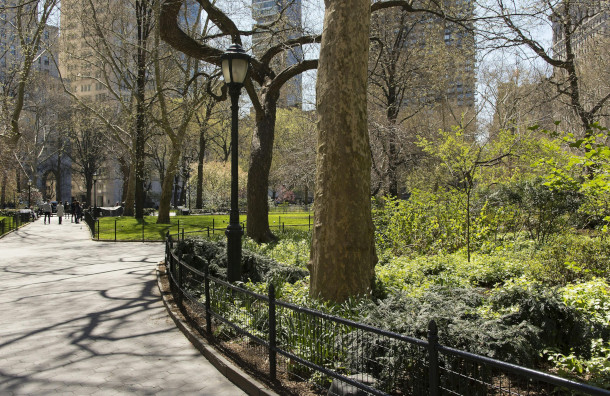
“Sponge cities” seek to decrease impermeable surfaces in urban areas, allowing for water to percolate down into the soil and protect against flood risk. (Photo: Pixabay, Pexels)
BELTRAN: Dr. Swain, what do you hope people will take away from your work on climate whiplash?
SWAIN: So I think one of the key takeaways is that increasing hydro climate whiplash, even if it hasn't emerged yet locally in your backyard, it probably will, sooner rather than later, with continued warming. This really is going to be, in all likelihood, a near universal experience over global land areas, nearly as much so as the warming temperatures themselves. And that tells us something about what the world is going to look like, and perhaps partly explains why we've experienced a lot of the things that we have recently. So there's been all this conversation in the wider world about how it feels like global warming has suddenly gotten worse in the last five or ten years, and I think increases in hydroclimate whiplash globally are potentially part of the reason why it feels like things are accelerating – it’s because they are. Hydroclimate whiplash increases at a faster rate than temperatures. So it probably should feel like we're seeing increased cycling between extreme wet events and extreme dry events, and the kind of associated transition risks like wildfires, because that is, in fact, what the climate models tell us the world should look like at this point and will continue to look more like moving forward. And so I think it does help us understand what we're seeing all around us today, on the one hand, and also hopefully gives us a clearer sense of what the future will look like, which is to say that we are going to see not just drier drys, not just wetter wets, but both, and often in the very same places.
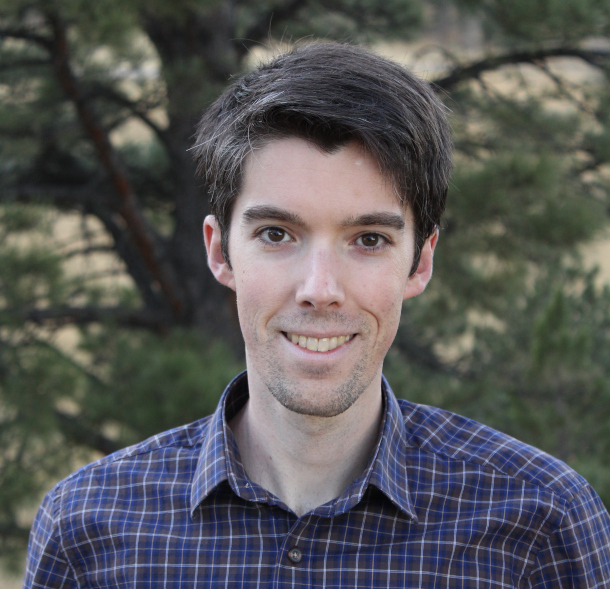
Dr. Daniel Swain is a climate scientist at the California Institute of Water Resources within the University of California Agriculture and Natural Resources & Institute of the Environment and Sustainability at UCLA. He is also a lead author on the paper. (Photo: Jilmarie Stephens)
BELTRAN: Dr. Daniel Swain is a climate scientist at the University of California Agriculture and Natural Resources. Thanks so much for joining us.
SWAIN: Thanks again for having me today.
Related links:
- Nature Reviews Earth & Environment | “Hydroclimate Volatility on a Warming Earth”
- The Guardian | “Climate ‘Whiplash’ Events Increasing Exponentially Around World”
[MUSIC: Eric Tingstad, “Solace” on A Sense of Place, by Eric Tingstad, Narada Productions]
Exploring the Parks: Brand-New Sáttítla Highlands National Monument
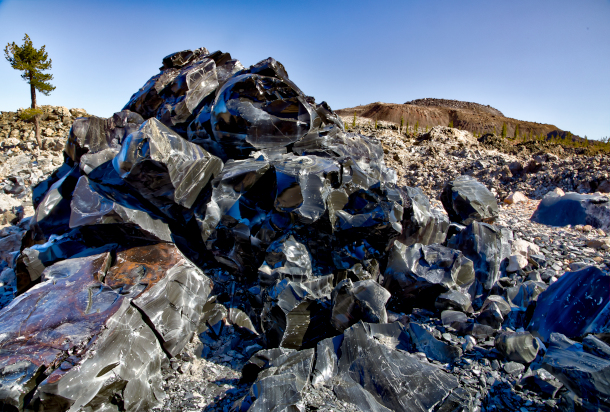
Sattitla means “obsidian place” in Achumawi, a language spoken by the Pit River people. (Photo: courtesy of Protect Sattitla Campaign)
BELTRAN: The Trump administration is once again considering redrawing the boundaries of national monuments. In his first term President Trump tried to drastically shrink Bears Ears and Grand Staircase Escalante in Utah but President Biden restored those boundaries. And just before leaving office, Joe Biden used his authority under the Antiquities Act to declare two new national monuments in California. It’s not clear if they too will be targeted for reduction by the Trump administration. But Jenni I had the honor of talking to some of the community leaders and tribal members who advocated for these recent monument designations.
DOERING: Yeah Paloma just the other week you shared with us the story behind the Chuckwalla National Monument. A beautiful desert landscape in SoCal Southern California that holds deep cultural and spiritual significance for several tribal communities.
BELTRAN: Yeah and that monument is located near Palm Desert in the Coachella Valley.
And if you take I-5 North from Chuckwalla and drive about 12 hours, you’ll end up in the Sáttítla Highlands National Monument. It’s also stunning but in a totally different way.
DOERING: Ooh! Okay, tell me more, Paloma.
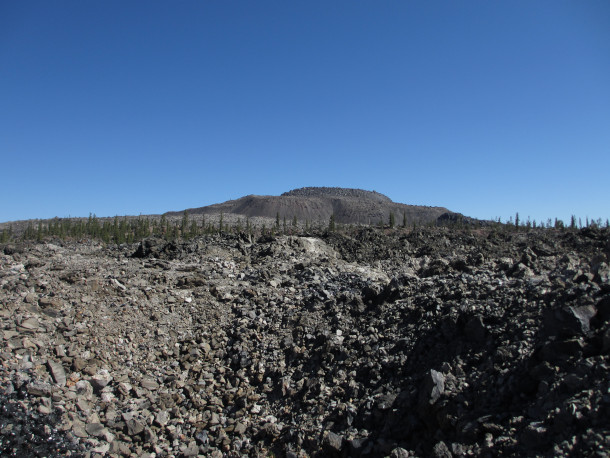
Glass Mountain is a spectacular, nearly treeless area made up of volcanic rock ago from an eruption that took place around a thousand years ago. (Photo: Petr Brož, Wikimedia Commons, CC BY-SA 3.0)
BELTRAN: Yeah, I’d be happy to. So Sáttítla means “obsidian place” in Achjumawi, a language spoken by the eleven bands of the Atsuwegi nation, also known as the Pit River people. The monument surrounds the Medicine Lake Highlands, where there’s a massive and dormant Medicine Lake Volcano not far from Mount Shasta. This area is a spiritual place for many of the indigenous tribes of northern California. And I talked to Brandy McDaniels, a Pit River Tribal spokesperson to learn more.
McDANIELS: Sáttítla is a very sacred place for the Pit River people. It's the actual location of our creation narrative. And these are described as by our people, as our church. These are holy lands. So in that way, it's very sacred. It's been touched by Hey-wee-see, it's God. We have been actively using these tribal cultural landscapes since time immemorial, since time began, since the first twinkling of light.
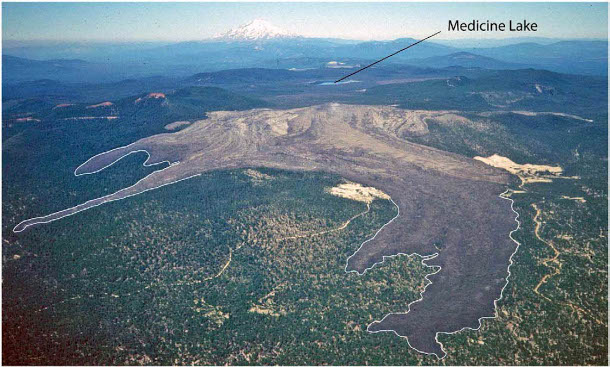
Aerial view west across the upper part of Medicine Lake Volcano toward Mount Shasta, with the caldera lake labeled in the distance. (Photo: Donnelly-Nolan, USGS.gov, Public Domain)
DOERING: Wow, sounds like a special place. And so how does this monument status give protections to Sáttítla?
BELTRAN: Well, the volcanic origins of the area make it attractive to geothermal developers. Geothermal energy is considered a renewable resource, because earth’s core continuously produces heat. It can involve the injection of hydrofluoric and hydrochloric acids that can release harmful chemicals into the air and water. This northern part of California is often referred to as the headwaters of the state since its volcanic rock naturally purifies water. So safeguarding Sáttítla protects clean water for millions of people as well as farms and ecosystems throughout the state.
DOERING: And Paloma, what does this volcanic landscape actually look like?
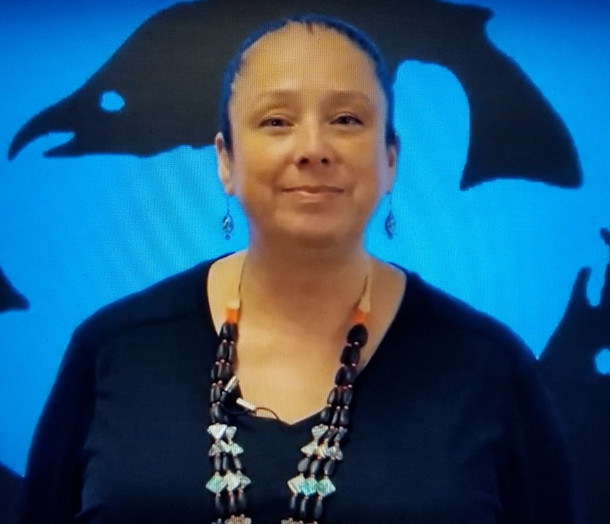
Brandy McDaniels is the spokesperson for the Pit River tribe. (Photo courtesy of Brandy McDaniels)
BELTRAN: Well, I asked Brandy to describe it for us and it truly sounds magical.
McDANIELS: If you were going up that way, first you would see Ako, which is also known as Mount Shasta, a very spiritually important place for us. And you would see forested areas. You would come in, and then you would encounter unique lava flows, caves. There's a lot of people that like to explore the volcanic landscape of the area, yeah, just stunning vistas and views.
BELTRAN: And, you know, that geologic history is incredible. Nick Joslin is the Forest and Watershed Program Manager at the Mount Shasta Bioregional Ecology Center, and he said that fiery past makes for some stunning features.
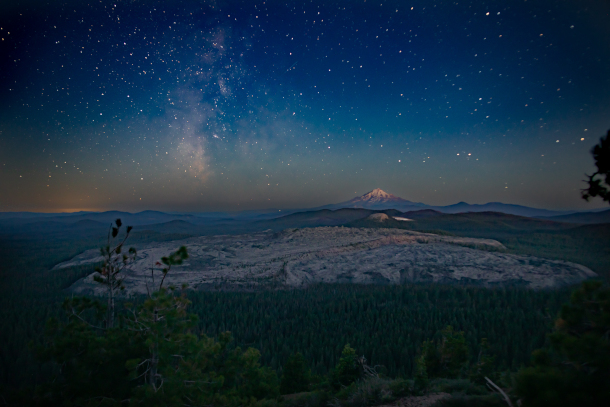
Medicine Lake Volcano, a shield volcano, is the largest volcano in the Cascades by volume. (Photo: courtesy of Bob Wick)
JOSLIN: Sáttítla and another sort of sister volcano called Newberry are shield volcanoes, so they are lower elevation, but broader and flatter shaped and due to their large size and as far as mass is concerned, those two are sort of the two largest, by mass, Cascade volcanoes. And so from a distance, it looks like a really gentle slope. And when you get up onto the actual volcano, the striking features are very recent lava flows.
DOERING: Oh! Wait, I’ve actually been to that sister volcano he mentioned, Newberry in southern Oregon. And you can hike through the obsidian flow there, it’s so cool.
BELTRAN: Yeah, and the obsidian at these volcanoes has been an important source of material for stone tools for thousands of years. Just be aware, the general public is not allowed to collect obsidian here. So, while some people like the Pit River tribes are used to this volcanic landscape, Nick says that for many folks it feels like being on another planet.
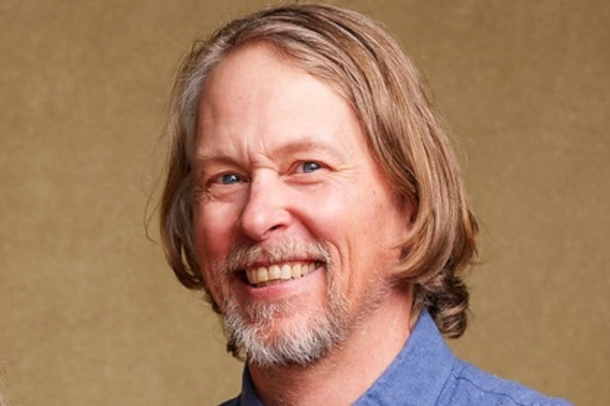
Nick Joslin is the Forest and Watershed Watch and Community Fire Resiliency Program Manager at Mount Shasta Bioregional Ecology Center. (Photo by Nick Joslin)
JOSLIN: So you'll be driving along the road through dense forest and then pop out into just a stark black landscape with almost nothing growing on it. And the top of the caldera is a large lake called Medicine Lake, and off in the distance, you can see a large obsidian flow that's like black glass. It just kind of shimmers in the sun. It's really kind of almost like a Martian landscape in places.
DOERING: Whoa, sounds out of this world. And by the way, Nick said there are very recent lava flows, so… how recent are we talking?
BELTRAN: He means ‘recent’ in geologic time. It’s dormant today and the last time lava flowed at Sáttítla was around 1,000 years ago. That said, it could become active again, so the US Geological Survey keeps a close eye on it.
DOERING: OK, good to know! [LAUGHS] And Paloma what sorts of animals call this area home?
BELTRAN: Well, there are tons of animals typical of a Cascade Range habitat like bears, mountain lions, wolves, eagles, and other raptors. There are also some old growth forests that house spotted owls.
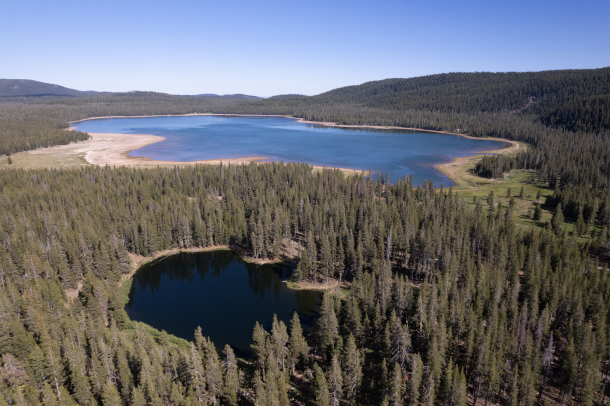
Medicine Lake is amongst the many lakes inside the Sattitla Highlands National Monument in northern California. (Photo: courtesy of Bob Wick)
DOERING: Oh, cool. So what should people know before visiting Sáttítla Highlands National Monument?
BELTRAN: It’s high country, so Nick said the best time to visit is after the snow melts, between late spring and early fall. It’s also pretty remote, and that can be a good thing.
JOSLIN: You are going far off the beaten path if you're going to go to this monument. You lose cell phone reception part way up the mountain, and it's worth it to sort of check out and have that ability to disconnect. It has some of the darkest skies in the lower 48 and it's a notably quiet place. So you're far enough away from light, you're far enough away from noise that you get an experience that is very hard to find these days.
DOERING: Oh man, that’s priceless in this day and age.
BELTRAN: I totally agree, Jenni.
DOERING: Well, what a gem! I’m definitely adding Sáttítla Highlands National Monument to my 2025 bucket list. Thank you so much, Paloma.
BELTRAN: Thank you, Jenni.
Related links:
- Learn more about the Sáttítla Highlands National Monument
- The Conservation Alliance | “National Monument: Save Sáttítla – Medicine Lake Highlands”
- Outside Magazine | “Biden Announces Two New National Monuments in California, Conserving 848,000 Acres”
- Learn about the Mount Shasta Bioregional Ecology Center
- Learn more about the Pit River Tribe
[MUSIC: Nashville Mandolin Ensemble “My Last Days on Earth” on Plectrasonics, by Bill Monroe, BMG]
DOERING: Coming up, a rare bipartisan effort to help everyone access America’s public lands. Stay tuned to Living on Earth.
ANNOUNCER: Support for Living on Earth comes from Friends of Smeagull the Seagull and Smeagull’s Guide to Wildlife. It’s all about the wildlife right next door to you! That’s Smeagull, S - M - E - A - G - U - L - L, SmeagullGuide.org.
[CUTAWAY MUSIC: Nashville Mandolin Ensemble “My Last Days on Earth” on Plectrasonics, by Bill Monroe, BMG]
"The Silence"- Lava Tubes of Iceland
The colorful ceiling of the lava tube with its “basalt fractured into uneven hexagons” arching overhead. (Photo: © Mark Seth Lender)
DOERING: It’s Living on Earth, I’m Jenni Doering
BELTRAN: And I’m Paloma Beltran.
Escaping the noise of the world can be hard these days but not impossible. Living on Earth’s Explorer in Residence Mark Seth Lender has stumbled upon silent sanctuaries in Iceland and beyond.
The Silence
Reykjanes Peninsula, Iceland
*
Marshfield Vermont
© 2024 Mark Seth Lender
All Rights Reserved
Through the place where I now stand, lava roared. Twenty, thirty kilometers an hour, viscous, four meters thick, the lava tube full completely. Unstoppable. Then, slowly, it drained out. Ripples of molten stone awash as the level fell leaving a crease along the wall and below that another. And another. Like tide marks, every pulse of eruption and subsidence recorded in a coarse surface of lines. Their colors, astonishing. Blue gray, purple black, red cadmium and orange. Basalt fractured into uneven hexagons arches overhead. The only natural illumination, the dim reflection from a white cone made of snow below a small skylight where the roof caved in. All along the floor stalagmites of ice reach up to meet the slow drip, drip, drip of water from above. My headlamp makes the ice glow, like candles, in a place of worship, hidden inside the earth; Memorial to heat long ago returned to the Source.
Snow below two skylights in the basalt roof. (Photo: © Mark Seth Lender)
Now silence rules here.
The silence of the stone deaf:
Tiny bubbles left in the walls of the lava tube swallow sound. Turn off the headlamp, you tumble into it, like freefalling in the blackness of outer space. Even the sibilance of my breathing, vanishes.
I am here. And not here.
Only once have I heard a silence like this. We were coming down Spruce Mountain in the pitch dark. There was no wind, the trees did not move, the tread of our Vibram soled boots muffled by the pine needles. Suddenly I felt the quiet. I put up both my hands. Listen! Listen! In an instant everyone understood. The hiss of our carbide headlamps, even this was too much and we took them down the trail away from us. We sat on the boulders by the side of the trail. We sat, for a long time. Sixty years ago on a mountain in Vermont. Kit Chisolm, Maisey Smith, and me. I am the only one left. But now, there is you. Now you also have that Silence.
DOERING: That’s Living on Earth’s Explorer in Residence, Mark Seth Lender.
Colors shift and blend in ombre patterns in the basalt (Photo: © Mark Seth Lender)
[MUSIC: Blue Dot Sessions “Dolly and Pad”]
DOERING: Hey, Paloma – I think we have time for a quick fun fact… did you know there are lava tubes on the Moon, too?
BELTRAN: Wait… does that mean there are volcanoes on the Moon as well?
DOERING: Yeah, exactly, and they’re also actually shield volcanoes a lot like the one that Mark explored in Iceland, and Medicine Lake Volcano in Sáttítla Highlands National Monument, for that matter. But the really cool part about these lunar lava tubes is that they’re way bigger than the ones on Earth. Like, ten times bigger!
BELTRAN: Whaat? That’s huge! How??
DOERING: I know, right?! Well, so there’s a lot less gravity on the Moon, right? So heavy things like a lava flow are, well, a lot less heavy. So they can just grow bigger. And these lunar lava tubes aren’t just cool – they might even give astronauts some shelter from the harsh lunar radiation, temperature swings and micrometeorites during future missions. But that’s another story, for another day.
BELTRAN: Wow Jenni, fascinating! Thanks for sharing!
DOERING: Hey, thanks for letting me nerd out!
Related links:
- More of Mark Seth Lender’s photography can be seen here
- Read the Field Note for this essay
- Mark’s travel in Iceland was facilitated by Destination: Wildlife
[MUSIC: Paul Simon, “Kodachrome” on There Goes Rhymin’ Simon, Sony Music Entertainment]
'EXPLORE' Act and Outdoor Accessibility
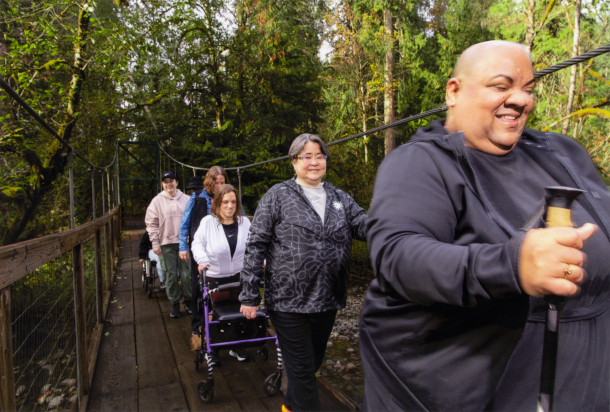
Disabled Hikers is a cross-disability-led nonprofit building disability community and justice in the outdoors. Shown here is a group hike led by Disabled Hikers. (Photo: Courtesy of Disabled Hikers)
DOERING: From the geysers of Yellowstone to the grasslands of the Everglades, the United States has set aside countless state and national parks for the public to enjoy. But not everybody feels like the parks were designed with their needs in mind. People with disabilities often face significant obstacles when they’re venturing outdoors. So a key part of the bipartisan EXPLORE Act, passed in December 2024, seeks to expand access to the great outdoors for people with disabilities in public lands nationwide. Syren Nagakyrie is the founder and director of the non profit Disabled Hikers and they’re here to talk to us about what true outdoor accessibility would look like. Welcome to Living on Earth, Syren!
NAGAKYRIE: Thank you for having me.
DOERING: So what personal experiences inspired you to create this organization, Disabled Hikers?
NAGAKYRIE: Yeah, I created Disabled Hikers in March of 2018, and I grew up with multiple disabilities and chronic illnesses, and I'm neurodivergent myself, and being outdoors has always kind of been this place of belonging and comfort for me. So I moved up to the Olympic Peninsula in Washington State, and was really excited to go out and experience this incredible new landscape. And did all of my research ahead of time about this particular trail in the Quinault Rainforest, and thought it was going to be accessible and doable for me. Got there and immediately encountered all of these obstacles and barriers like steep stairs and rocky drop offs that were really difficult for me, and it put me in a really dangerous situation. And I was exhausted and in pain, and kind of wound up at this bridge over a waterfall, and just stopped there for a moment watching the water flow, and in that moment, was just really inspired and said, you know, I'm going to do something about this. And went home and wrote up a trail guide, put up a blog post, and Disabled Hikers was kind of born from there.
DOERING: So kind of talking more broadly, what barriers do people with disabilities face when it comes to accessing the outdoors?
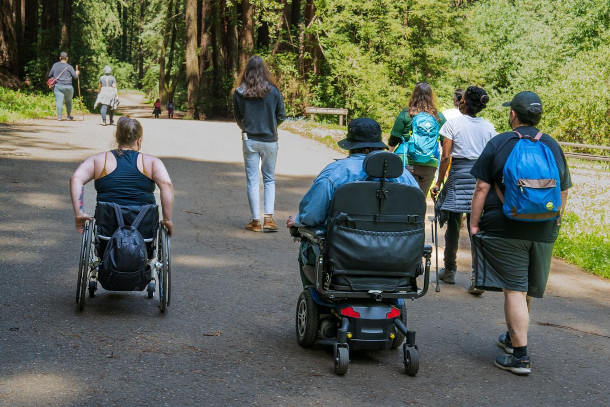
People with physical and mental disabilities face many obstacles when getting outdoors. Organizations like Disabled Hikers advocate for removing as many of those barriers as possible. (Photo: Orenda Randuch, Courtesy of Disabled Hikers)
NAGAKYRIE: Yeah, there's so many different types of barriers, and it really depends on the type of disability that people have, again, like steep stairs and rocky areas, things like steep cross slopes, which is the steepness on the, kind of the horizontal on the trail. That can be really difficult for people to walk on if they have balance issues or limb difference. Things like lack of benches, lack of water fountains, restrooms, kind of those amenities that really help make a trail more accessible for people. Things like clear information, clear signage, all of that. There's really so many different types of barriers out there.
DOERING: And you know, some disabilities are physical and they, they may or may not be super visible to other people on the trail. But I understand there's also mental disabilities that can make it harder, just like the experience of getting outdoors can be a challenge for people. So what do those include?
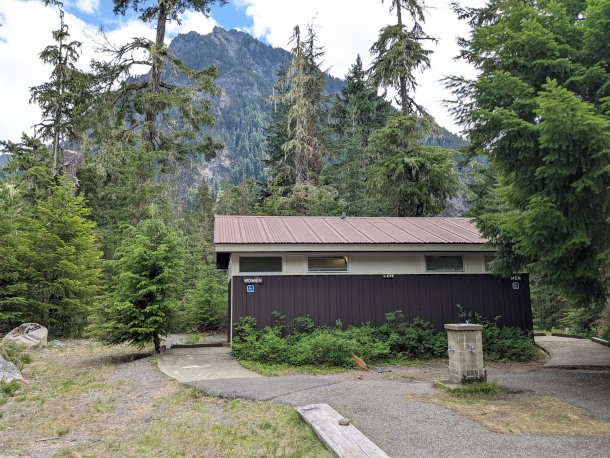
Access to amenities like benches, bathrooms, and water fountains can help people with disabilities navigate the outdoors. (Photo: NPS Photo, Wikimedia Commons, Public Domain)
NAGAKYRIE: Absolutely. So, you know myself, as I mentioned, I'm neurodivergent, so you know, I'm autistic and have ADHD. But there's also multiple types of neurodiversity out there, which is really just a term to refer to, really, the diversity of ways that brains process and exist and live in this world and interact with the world. And I can get really kind of confused and disoriented on a trail, especially if there's not good directions and no good maps. I get very overwhelmed. So I'm trying to process all of this information at once, trying to figure out where I am. So having that really clear direction on how to go and how to hike the trail is really helpful, too.
DOERING: You know, I think some people might assume that outdoor accessibility just means adding a sidewalk or a ramp to a park and calling it a day, but there really seems to be a lot more to it than that. What would true outdoor accessibility look like to you?
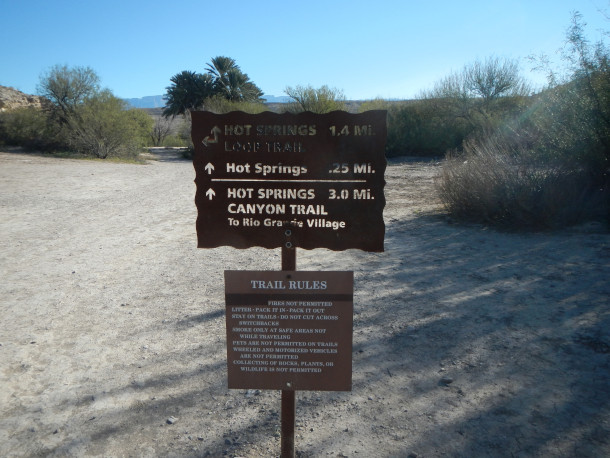
Clear trail directions also help improve accessibility. (Photo: JRick1, Wikimedia Commons, CC BY-SA 3.0)
NAGAKYRIE: Yeah, I think true outdoor accessibility, again, is really incredibly varied and diverse. So for example, it's things like Braille signage, it's tactile markers on trails for people who are blind, audio description units, access to, again, benches, water fountains, restrooms, those kind of amenities. And even, not everyone who is physically disabled or uses a wheelchair even wants paved paths and sidewalks. You know, there are lots of, for example, All Terrain wheelchairs and things like that, that are able to navigate more natural surfaces, and they want to have that kind of experience. And I think that people really think that what we want to do is pave over the wilderness, create all these sidewalks and paved trails and roads and things like that, and that is absolutely not what we advocate for. It's not what I want. It's really just about removing as many barriers as possible and creating space for disabled people to feel welcome and included and as part of the community. And I think often, you know, people approach these outdoor activities as, to be authentic and valid, you have to be out there climbing a 14,000 foot mountain or going for a multi day backpacking trip. But for us, we go out and hike maybe a half mile or a mile, and spend a couple of hours and spend a lot of time just looking at the trees and the plants and being in community, and that is absolutely a meaningful experience for everyone who attends.
DOERING: It's just as valid of an experience in the outdoors, in nature, as scaling a 14,000 footer, is what I hear you saying.
NAGAKYRIE: Mm hm, absolutely.
DOERING: So there's actually some legislation that was passed, the bipartisan EXPLORE Act was passed in December of 2024 and it seeks to, in part, improve access to the outdoors across the nation. To what extent do you think this act might have a real impact on the way that people with disabilities are able to experience the outdoors in the US?
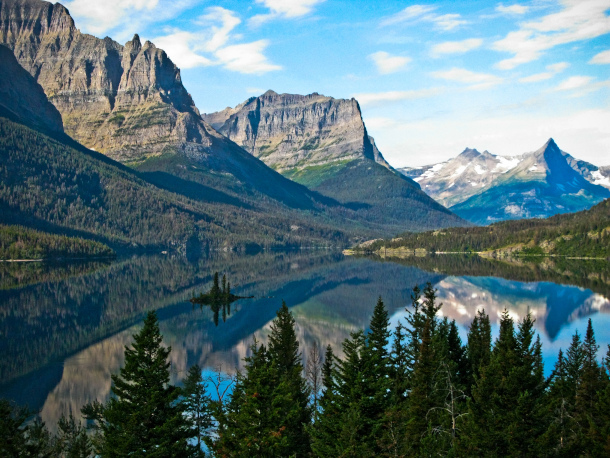
The bipartisan EXPLORE Act, passed in December 2024, aims in part to improve outdoor accessibility in public lands across the country. (Photo: Dave Sizer, Wikimedia Commons, CC BY 2.0)
NAGAKYRIE: Yeah, I'm very excited about this Act and it being now enshrined in law that the agencies have to start really addressing this. So I think having much more access to information, as I mentioned before, is so incredibly important, and that is a part of this law. It's requiring federal agencies to go out and do trail assessments and then provide that information to the public, and then to construct additional accessible trails and accessible recreation opportunities. And the Act definitely requires improved signage on trails, that kind of includes some of that basic trail accessibility information. So for example, length, width, grade, things like that, which is very focused on physical accessibility, which is again, very important, but not the entire picture, right, of what accessibility in the outdoors means or looks like. So I think signage also needs to focus on the directional component on a trail, so that they know where to go and how far to go on that trail. And I'm excited about, specifically, the stakeholder engagement piece. I think having that as a part of the law is so important. As someone who runs a community based organization, we're often left out of these decisions. So reaching out to the community is really important, and that has a huge impact on how these projects kind of come to fruition. And this law does not have funding attached to it yet, so hopefully there will be funding that has now become available for these projects.
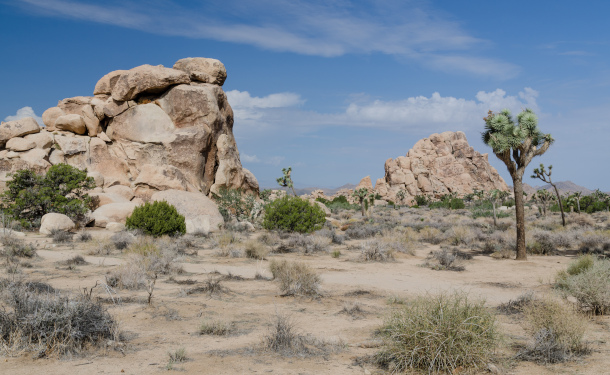
Contrary to popular belief, our guest Syren Nagakyrie says, accessibility does not mean simply paving over the wilderness. Instead, the focus is on removing barriers to access. (Photo: Tuxyso, Wikimedia Commons, Public Domain)
DOERING: I guess it's a authorization bill as opposed to a funding allocation bill.
NAGAKYRIE: Right, yeah.
DOERING: How partisan of an issue do you think this kind of access for people to the outdoors has become, or does it have a lot of opportunity to be a bipartisan issue that people of all different political persuasions come together on?
NAGAKYRIE: Yeah, I definitely think that it is and should be a bipartisan issue. Twenty five percent of the population is disabled, and we run all political spectrums and ideas. Unfortunately, I do think currently it is becoming a partisan issue, especially with the attacks on DEI, and accessibility is a part of that. So even within my own organization, in the last week or two, we've been facing loss of funding and loss of partnerships and things like that, because it is becoming such a politicized issue.
DOERING: I'm sorry to hear, that must be tough.
NAGAKYRIE: Yeah, it's difficult.
DOERING: And Syren, why do you spend time outdoors?
NAGAKYRIE: Yeah, for me, being outdoors is really about finding that sense of belonging and sense of connection. When I'm outside, I really, I experience disability in the landscape, you know, and I see my own experiences reflected there, and it really helps me feel like I have a place to belong, where society may tell me that I don't. I absolutely see disability as natural. You know, I think for a very long time, there has been this assumption that disability is not natural, that disability becomes removed from the natural ecosystem. But in truth, you know, even we see it in animals, that they take care of disabled individuals, and that even in the landscape, you know, we see things like plants, where they're growing in multiple different ways. And I think very often, people will go out and actually seek out that which is really unique in the landscape, so whether it's a uniquely growing tree, and they will seek that out as really unique and special. But when it comes to disabled people, they don't see us that way. So for me, being out in nature and really seeing how beautiful and special and unique these places are is really meaningful to me.
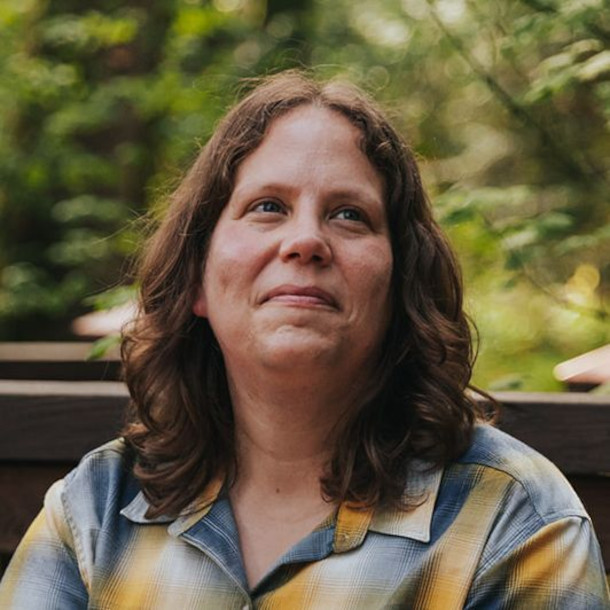
Syren Nagakyrie is the founder and director of the nonprofit Disabled Hikers. (Photo: Marissa Solini Photography)
DOERING: Why do you think it's important for society as a whole to prioritize accessibility and thinking about all kinds of different people being able to get outside? I mean, why is it important for society itself to take a look at this?
NAGAKYRIE: Yeah, absolutely. I think as a society, we have a responsibility to take care of each other, right? And that includes people who are disabled, and if you live long enough, you will have changes in your mobility and health that change the way that you engage with the outdoors. And again, I think that it's so important for people to recognize that disability is natural. It's a natural part of the way that human bodies and all bodies live and exist, and it's a normal way to be. And recognizing that is really important. And once we recognize that, then we can start saying, okay, so how do we normalize this? How do we make sure that people with disabilities are really included in all of these things that we value? And I think it's fair to say that in this country, with the National Park Service and all of that, we very much value access to these places, so disabled people should have access to that as well.
DOERING: Syren Nagakyrie is the founder and director of the nonprofit Disabled Hikers. Thank you so much, Syren.
NAGAKYRIE: Thank you.
Related links:
- Read the EXPLORE Act
- Learn more about Disabled Hikers
[MUSIC: Phillip LaRue “Marigold” on The Meaning, Nettwerk Music Group Inc.]
BELTRAN: Next time on Living on Earth, Reverend Benjamin Chavis Jr led the protests fighting against what he first called, environmental racism in 1981 in Warren County, North Carolina, where a toxic waste dump was getting sited in a predominantly black community. And he got his start working with Dr. Martin Luther King, Jr.
CHAVIS: Dr. King said, “An injustice anywhere is a threat to justice everywhere.” So I would say, an environmental injustice anywhere is a threat to justice everywhere. I would say a climate injustice is anywhere is a threat to climate justice everywhere. So I think that what I've learned in the movement is, change is possible to the extent to which people get involved and stay involved, and not let their spirit get broken. You asked me earlier about the importance of faith. One of the things I tell young people, and I tell people even my age: whatever happens to you in life, there will be disappointments, there will be trials and tribulations. But at the end of the day, never let anyone or anything break your spirit. Having that strong spirit to stand up, to speak out, to organize, to mobilize, is something that is really needed today. A lot of people had their hearts broken because Kamala Harris did not win the election. Well, we got to mend our broken hearts. We have to mend our broken spirits. We just can't go down in the dumps and fall down on someone who wants to be king of America. What we have to do is to mobilize and organize anew.
BELTRAN: How the quest for civil rights also became in this case the quest for environmental justice, next time on Living on Earth.
[MUSIC: Grant Green “The Selma March” on Anthology, U-5]
DOERING: Living on Earth is produced by the World Media Foundation. Our crew includes Naomi Arenberg, Kayla Bradley, Daniela Faria, Mehek Gagneja, Swayam Gagneja, Mark Kausch, Mark Seth Lender, Don Lyman, Ashanti McLean, Nana Mohammed, Aynsley O’Neill, Sophia Pandelidis, Jake Rego, Andrew Skerritt, Melba Torres, and El Wilson.
BELTRAN: Tom Tiger engineered our show. Alison Lirish Dean composed our themes. Special thanks this week to Destination: Wildlife. You can hear us anytime at L-O-E dot org, Apple Podcasts and You Tube music, and like us, please, on our Facebook page - Living on Earth. We tweet from @livingonearth. And find us on Instagram at livingonearthradio. And we always welcome your feedback at comments at loe.org
Steve Curwood is our Executive Producer. I’m Jenni Doering.
BELTRAN: And I’m Paloma Beltran. Thanks for listening!
ANNOUNCER: Funding for Living on Earth comes from you, our listeners, and from the University of Massachusetts, Boston, in association with its School for the Environment, developing the next generation of environmental leaders. And from the Grantham Foundation for the protection of the environment, supporting strategic communications and collaboration in solving the world’s most pressing environmental problems.
ANNOUNCER 2: PRX.
Living on Earth wants to hear from you!
Living on Earth
62 Calef Highway, Suite 212
Lee, NH 03861
Telephone: 617-287-4121
E-mail: comments@loe.org
Newsletter [Click here]
Donate to Living on Earth!
Living on Earth is an independent media program and relies entirely on contributions from listeners and institutions supporting public service. Please donate now to preserve an independent environmental voice.
NewsletterLiving on Earth offers a weekly delivery of the show's rundown to your mailbox. Sign up for our newsletter today!
 Sailors For The Sea: Be the change you want to sea.
Sailors For The Sea: Be the change you want to sea.
 The Grantham Foundation for the Protection of the Environment: Committed to protecting and improving the health of the global environment.
The Grantham Foundation for the Protection of the Environment: Committed to protecting and improving the health of the global environment.
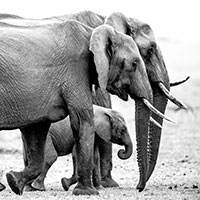 Contribute to Living on Earth and receive, as our gift to you, an archival print of one of Mark Seth Lender's extraordinary wildlife photographs. Follow the link to see Mark's current collection of photographs.
Contribute to Living on Earth and receive, as our gift to you, an archival print of one of Mark Seth Lender's extraordinary wildlife photographs. Follow the link to see Mark's current collection of photographs.
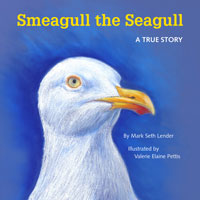 Buy a signed copy of Mark Seth Lender's book Smeagull the Seagull & support Living on Earth
Buy a signed copy of Mark Seth Lender's book Smeagull the Seagull & support Living on Earth

